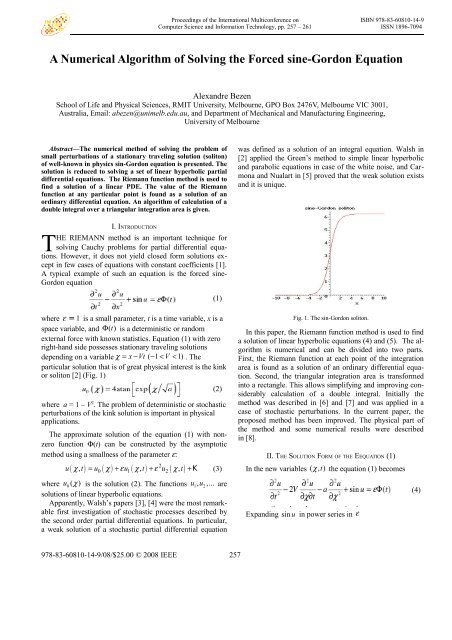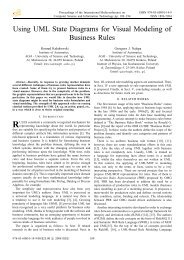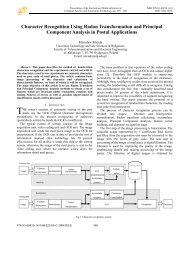Numerical Algorithm of Solving the Forced sin-Gordon Equation
Numerical Algorithm of Solving the Forced sin-Gordon Equation
Numerical Algorithm of Solving the Forced sin-Gordon Equation
Create successful ePaper yourself
Turn your PDF publications into a flip-book with our unique Google optimized e-Paper software.
Proceedings <strong>of</strong> <strong>the</strong> International Multiconference on ISBN 978-83-60810-14-9Computer Science and Information Technology, pp. 257 – 261 ISSN 1896-7094A <strong>Numerical</strong> <strong>Algorithm</strong> <strong>of</strong> <strong>Solving</strong> <strong>the</strong> <strong>Forced</strong> <strong>sin</strong>e-<strong>Gordon</strong> <strong>Equation</strong>Alexandre BezenSchool <strong>of</strong> Life and Physical Sciences, RMIT University, Melbourne, GPO Box 2476V, Melbourne VIC 3001,Australia, Email: abezen@unimelb.edu.au, and Department <strong>of</strong> Mechanical and Manufacturing Engineering,University <strong>of</strong> MelbourneAbstract—The numerical method <strong>of</strong> solving <strong>the</strong> problem <strong>of</strong>small perturbations <strong>of</strong> a stationary traveling solution (soliton)<strong>of</strong> well-known in physics <strong>sin</strong>-<strong>Gordon</strong> equation is presented. Thesolution is reduced to solving a set <strong>of</strong> linear hyperbolic partialdifferential equations. The Riemann function method is used t<strong>of</strong>ind a solution <strong>of</strong> a linear PDE. The value <strong>of</strong> <strong>the</strong> Riemannfunction at any particular point is found as a solution <strong>of</strong> anordinary differential equation. An algorithm <strong>of</strong> calculation <strong>of</strong> adouble integral over a triangular integration area is given.was defined as a solution <strong>of</strong> an integral equation. Walsh in[2] applied <strong>the</strong> Green’s method to simple linear hyperbolicand parabolic equations in case <strong>of</strong> <strong>the</strong> white noise, and Carmonaand Nualart in [5] proved that <strong>the</strong> weak solution existsand it is unique.TI. INTRODUCTIONHE RIEMANN method is an important technique forsolving Cauchy problems for partial differential equations.However, it does not yield closed form solutions exceptin few cases <strong>of</strong> equations with constant coefficients [1].A typical example <strong>of</strong> such an equation is <strong>the</strong> forced <strong>sin</strong>e-<strong>Gordon</strong> equation(1)where ε = 1 is a small parameter, t is a time variable, x is aspace variable, and Φ ( t)is a deterministic or randomexternal force with known statistics. <strong>Equation</strong> (1) with zeroright-hand side possesses stationary traveling solutionsdepending on a variable χ = x −Vt ( − 1 < V < 1) . Theparticular solution that is <strong>of</strong> great physical interest is <strong>the</strong> kinkor soliton [2] (Fig. 1)where a = 1 – V 2 . The problem <strong>of</strong> deterministic or stochasticperturbations <strong>of</strong> <strong>the</strong> kink solution is important in physicalapplications.The approximate solution <strong>of</strong> <strong>the</strong> equation (1) with nonzer<strong>of</strong>unction Φ(t) can be constructed by <strong>the</strong> asymptoticmethod u<strong>sin</strong>g a smallness <strong>of</strong> <strong>the</strong> parameter ε:( χ, ) ( χ ) ε ( χ, ) ε 2 ( χ,)0 1 2(2)u t = u + u t + u t +K (3)where u ( χ ) is <strong>the</strong> solution (2). The functions 0u1, u2,...aresolutions <strong>of</strong> linear hyperbolic equations.Apparently, Walsh’s papers [3], [4] were <strong>the</strong> most remarkablefirst investigation <strong>of</strong> stochastic processes described by<strong>the</strong> second order partial differential equations. In particular,a weak solution <strong>of</strong> a stochastic partial differential equationFig. 1. The <strong>sin</strong>-<strong>Gordon</strong> soliton.In this paper, <strong>the</strong> Riemann function method is used to finda solution <strong>of</strong> linear hyperbolic equations (4) and (5). The algorithmis numerical and can be divided into two parts.First, <strong>the</strong> Riemann function at each point <strong>of</strong> <strong>the</strong> integrationarea is found as a solution <strong>of</strong> an ordinary differential equation.Second, <strong>the</strong> triangular integration area is transformedinto a rectangle. This allows simplifying and improving considerablycalculation <strong>of</strong> a double integral. Initially <strong>the</strong>method was described in [6] and [7] and was applied in acase <strong>of</strong> stochastic perturbations. In <strong>the</strong> current paper, <strong>the</strong>proposed method has been improved. The physical part <strong>of</strong><strong>the</strong> method and some numerical results were describedin [8].II. THE SOLUTION FORM OF THE EEQUATION (1)In <strong>the</strong> new variables ( χ , t)<strong>the</strong> equation (1) becomesExpanding <strong>sin</strong> u in power series in ε(4)978-83-60810-14-9/08/$25.00 © 2008 IEEE 257
258 PROCEEDINGS OF THE IMCSIT. VOLUME 3, 2008(5)Substituting (3) and (5) into (4) in <strong>the</strong> first order on εwe obtainIn <strong>the</strong> second order(6)(7)To apply <strong>the</strong> Riemann’s method <strong>of</strong> solving (6) and (7) [1]we need to transform <strong>the</strong>se equations to <strong>the</strong> standard formwhich does not contain <strong>the</strong> second mixed derivative. Toget rid <strong>of</strong> <strong>the</strong> mixed derivatives let us make a transformationχ = χ V χandτ = t − . In <strong>the</strong> new variables equationsa(6) and (7) read(8)Fig .2. The function f ( χ ) , a = 1 .The corrections ui( 0 0 )0 ( 0 ) ( χ , τ )χ , τ , i = 1, 2 to <strong>the</strong> kink solutionu χ at a point 0 0 can be presented through <strong>the</strong>Riemann function ω( χ, τ ) [1]:(13)and(9)with trivial initial conditions over <strong>the</strong> straight line CVC : τ = − ξ(10)a(14)where A is <strong>the</strong> characteristic triangle in <strong>the</strong> plane ( χ, τ ),bounded by <strong>the</strong> straight line C given in (10) and <strong>the</strong> characteristicsA : τ ( χ − χ0 ) = τ10 (Fig. 3).aIII. THE RIEMANN FUNCTION<strong>Equation</strong>s (8) and (9) have <strong>the</strong> same left-hand side andcan be presented as(11)(12)wheref2( χ) 2 / cosh ( χ / a)= <strong>sin</strong>ce1χacos[4arctan( e )] = 1−212cosh ( χ)aThe graph <strong>of</strong> <strong>the</strong> function f ( χ ) for <strong>the</strong> value V = 0.5is shown in Fig. 2.Fig. 3. The characteristic triangle A.The Riemann function ω( χ, τ ) satisfies <strong>the</strong> equation(15)with ω = 1/(2a) over <strong>the</strong> characteristics and b= a .
ALEXANDRE BEZEN: NUMERICAL ALGORITHM OF SOLVING THE FORCED SIN-GORDON EQUATION 259Since outside <strong>of</strong> a finite interval ( − χlim , χlim)<strong>the</strong>n one can expect that <strong>the</strong> solution <strong>of</strong> (15) can be closeto <strong>the</strong> solution <strong>of</strong> <strong>the</strong> telegrapher’s equation [1]:1which is ω( χ, τ ) =0( )2aJ b γ and2 12γ = ( τ −τ 0) − ( χ − χ2 0) . The variable γ is a hyperbolicdistance in <strong>the</strong> characteristic triangle A . The dis-atance γ2 12is positive inside A, i.e. ( τ − τ0) > ( χ − χ2 0) ,a2 12and imaginary when ( τ − τ0) < ( χ − χ2 0) . It vanishesa2 12when ( τ − τ0) = ( χ − χ2 0) .aThe equation (15) in <strong>the</strong> variables ( χ, γ ) has <strong>the</strong> formLet’s look for <strong>the</strong> solution <strong>of</strong> (16) in <strong>the</strong> form(16)(17)where <strong>the</strong> first term <strong>of</strong> <strong>the</strong> sum is <strong>the</strong> solution <strong>of</strong> <strong>the</strong>telegrapher’s equation and <strong>the</strong> second term must be smallfor a finite value <strong>of</strong> χlim .Since1J0 ( bγ ) + J0 ( bγ ) + J0( bγ) = 0bγ<strong>the</strong>n substitution <strong>of</strong> (17) into (16) givesFor χ = χ0<strong>the</strong> last equation becomesAssumeA = 0 for odd n,AAnIt follows thatand1 f ( ξ ) 1=,02 22 a ϕ( ξ0) 2f ( ξ ) ( −1)a= [ + ( ( ) −2a 2 4 ...(2 k)bk202k+ 2ϕ ξ2 2 2 2 01(1 − f ( ξ0 )) ϕ( ξ0 )) A2 k] ,2(2k+ 2) ϕ( ξ )k = 1,2,3...Ak1 ( −1)= , k = 1,2,3...2a2 4 ...(2 k)2k+ 2 2 2 20(17)1ω( χ, γ ) = [ J0 ( bγ ) + (1 − J0( bγ )) ϕ( χ)](18)2aSubstitute (18) into (16) and we obtain that <strong>the</strong> solutionϕ( χ ) satisfies <strong>the</strong> following equation−a(1 − J ( bγ )) ϕ ( χ)+0( J ( bγ ) + J ( bγ ))( χ − χ ) ϕᄁ( χ)+0 2 0(1 − f ( χ )(1 − J ( bγ ))) ϕ( χ) = J ( bγ ) f ( χ)0 0and subject to <strong>the</strong> boundary conditionsIV. NUMERICAL ALGORITHM AND CALCULATIONS(19)(20)A solution ω( χ1, τ1)<strong>of</strong> <strong>the</strong> partial differential equation(15) at any particular point ( χ1, τ1)can be reduced tosolving <strong>the</strong> boundary value problem (19), (20) with fixedvalue <strong>of</strong> γ , where2 12γ = ( τ1 −τ 0) − ( χ2 1− χ0) .aA family <strong>of</strong> curves γ = const define hyperbolaeimbedded into <strong>the</strong> characteristic triangle (Fig.4). Thesolution surface (15) can be represented as a family <strong>of</strong>curves over <strong>the</strong> hyperbolae in <strong>the</strong> 3D space ( χ, τ , ω ) .The surface representing <strong>the</strong> Riemann function for χ0= 0is shown in Fig. 5 and was drawn u<strong>sin</strong>g MAPLE.and, <strong>the</strong>refore,
260 PROCEEDINGS OF THE IMCSIT. VOLUME 3, 2008This transformation allows simplifying significantly numericalintegration and speed up <strong>the</strong> algorithm <strong>of</strong> calculation<strong>of</strong> functions u 1,2.(χ, t). The area <strong>of</strong> integration can becovered by a rectangular mesh and <strong>the</strong>n, <strong>the</strong> standardSimpson method can be used [9].Fig. 4. The Characteristic triangle with <strong>the</strong> family <strong>of</strong> curvesconst γ = .Fig. 6. The rectangular integration area R(v, u).The first integral (13) in <strong>the</strong> new variables (v, u) has<strong>the</strong> form(21)Fig. 5. The solution surface <strong>of</strong> (15) representing <strong>the</strong> Riemannfunction. Each curve is a solution <strong>of</strong> (19), (20) for particular fixedvalue <strong>of</strong> γ .The boundary value problem (19), (20) can be solvednumerically u<strong>sin</strong>g <strong>the</strong> relaxation method [9]. Since <strong>the</strong> solution<strong>of</strong> this BVP approaches zero when ±∞ <strong>the</strong>nfor numerical calculations this problem can be solved forfinite values <strong>of</strong> χ which are found manually from <strong>the</strong>limcondition .In <strong>the</strong> numerical calculations <strong>of</strong> <strong>the</strong> double integrals(13) and (14) one <strong>of</strong> <strong>the</strong> most difficult tasks is integrationover <strong>the</strong> triangle A . First, <strong>the</strong> integral needs to becalculated for various values <strong>of</strong> ( χ0, τ0). The area <strong>of</strong> <strong>the</strong>rectangle A becomes larger when <strong>the</strong> value <strong>of</strong> τ0 increases.The second difficulty is that changing <strong>the</strong> value <strong>of</strong><strong>the</strong> parameter a leads to changing <strong>the</strong> rectangle A shape.Therefore, it is very difficult to develop a universalalgorithm for various values <strong>of</strong> ( χ0, τ0) and <strong>the</strong> parametera . The integration area A (Fig. 3) can be mapped into awhere <strong>the</strong> double integral is calculated u<strong>sin</strong>g <strong>the</strong> Simpsonmethod and <strong>the</strong> value <strong>of</strong> ϕ ( v, u)at each point <strong>of</strong> <strong>the</strong> integralsum is a solution <strong>of</strong> <strong>the</strong> boundary value problem(19), (20).The numerical algorithm was implemented in a programwritten in C++. For calculating values <strong>of</strong> <strong>the</strong> Besselfunctions, double integrals and solving ordinary differentialequations <strong>the</strong> code given in [9] was used.As an example, <strong>the</strong> function Φ ( t) = <strong>sin</strong>(10 t)was considered.Two graphs in a plane ( x, u1) representing results<strong>of</strong> calculations <strong>of</strong> <strong>the</strong> integral (21) forareshown in Fig. 7 and Fig. 8.rectangle(Fig. 6) with coordinates(v, u) by means <strong>of</strong> transformationFig. 7. V = 0.95, t = πwhere t 0= τ 0+ V χ 0/ a .
ALEXANDRE BEZEN: NUMERICAL ALGORITHM OF SOLVING THE FORCED SIN-GORDON EQUATION 261Fig. 8. V = 0, t = 4088The values <strong>of</strong> ε in (3) depend on a particular physicalproblem and are not discussed in this paper. They can beup to 0.3 in some cases.REFERENCES[1] E. Zauderer, “Partial differential equations <strong>of</strong> applied ma<strong>the</strong>matics”,John Wiley & Sons Inc., USA, 1989.[2] Ablowitz MJ, Segur H. “Solitons and <strong>the</strong> Inverse Scattering Transform”,SIAM, Philadelphia, 1981.[3] J. B. Walsh, “An Introduction to stochastic partial differentialequations”, Lecture Notes in Ma<strong>the</strong>matics, 1180, Springer,pp. 266-437, 1986.[4] B. Cairoli, J.B. Walsh, “Stochastic integrals in <strong>the</strong> plane”, ActaMatematica, 134, pp.111-183, 1975.[5] R. Carmona, D. Nualart, “Random non-linear wave equations:Smothness <strong>of</strong> <strong>the</strong> solutions”, Prob. Theory Rel Fields, 79,pp.469-508, 1988.[6] A. Bezen, “The Riemann’s function for a linear hyperbolic PDE”,Analysis paper, Department <strong>of</strong> Statistics, University <strong>of</strong> Melbourne,Report No 10, 1996.[7] A. Bezen, F. Klebaner, “The Riemann’s function and its applicationto stochastic perturbations <strong>of</strong> a non-linear wave equation”,Random & Computational Dynamics, 5(4), pp.307-318, 1997.[8] A. Bezen, Y. Stepanyants, “Kink propagation within <strong>the</strong> forced<strong>sin</strong>e-<strong>Gordon</strong> equation”, Proceedings <strong>of</strong> III International Conference“Frontiers <strong>of</strong> Nonlinear Physics”, Nizhny Novgorod, 3-9July, pp.50-51, 2007.[9] W. H. Press, S. A. Teukolsky, W. T. Vetterling, B. P. Flannery,“<strong>Numerical</strong> Recipes in C”, Cambridge Universiy Press, 1992.




